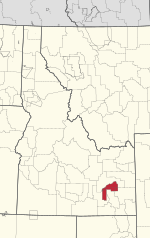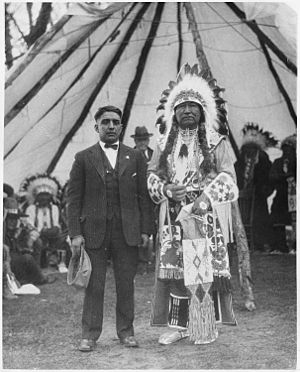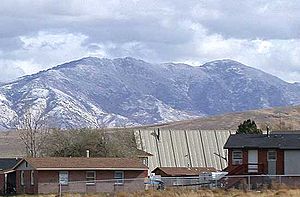Fort Hall Indian Reservation facts for kids
Quick facts for kids
Fort Hall Indian Reservation
|
|
|---|---|

Location of Fort Hall Indian Reservation
|
|
| Tribe | Shoshone-Bannock |
| Country | United States |
| State | Idaho |
| County | Bingham, Power, Bannock, and Caribou |
| Area | |
| • Total | 2,110.51 km2 (814.87 sq mi) |
| Website | Shoshone-Bannock Tribes |
The Fort Hall Reservation is a special area of land set aside for the Shoshone and Bannock Native American Tribes. It is located in the state of Idaho in the United States. This reservation is one of five tribes officially recognized by the U.S. government in Idaho.
You can find the reservation in southeastern Idaho, on the Snake River Plain. It's about 20 miles (32 km) north and west of the city of Pocatello. The reservation covers a large area of land, about 815 square miles (2,110 square kilometers). This land spreads across four different counties: Bingham, Power, Bannock, and Caribou. To the east, there are mountains called the Portneuf Range. Two mountains, Mount Putnam and South Putnam Mountain, are also on the reservation.
The Fort Hall Reservation was created in 1868 through a special agreement called a treaty. It is named after Fort Hall, which was an important trading post for early European American settlers. This fort was a key stop along famous routes like the Oregon Trail and California Trail in the mid-1800s. Today, a monument on the reservation shows where the old fort used to be. The main town on the reservation is also called Fort Hall, and you can reach it by Interstate 15.
More than 5,300 people are official members of the Shoshone-Bannock Tribes. Over half of them live on the Fort Hall Reservation. The tribes have their own government, which is run by a council of seven elected members. They provide many services for their community, including law enforcement, courts, health services, and education.
Contents
History of the Fort Hall Reservation

The Shoshone and Bannock people have lived in Idaho and nearby areas for a very long time. Their way of life began to change in the late 1840s and 1850s. This was when many wagon trains of settlers started crossing their lands. These settlers used up food and water, which made it harder for the tribes to find resources.
In the 1850s, the Shoshone, led by Chief Pocatello, sometimes attacked these settler groups. They wanted to protect their hunting grounds and resources. Later, a group of settlers called the Mormons tried to make peace with the Shoshone.
However, other settlers complained about the Native Americans. The U.S. Army was sent into the Utah Territory in 1858. This led to more fighting between the U.S. and the Shoshone. The tribes and the settlers were competing for land and resources.
In January 1863, U.S. Army forces attacked a group of Shoshone people. This event is known as the Bear River massacre. More than 400 Shoshone, including women and children, were killed in what is now southeastern Idaho. Chief Pocatello had moved his people away before the attack.
After seeing the power of the U.S. forces, Chief Pocatello decided to seek peace. In 1868, he agreed to move his people to a new reservation along the Snake River. Four groups of Shoshone and one group of Bannock people moved to this new reservation. It was very large, covering about 1.8 million acres (7,300 square kilometers) at that time. As part of the Fort Bridger Treaty of 1868, the U.S. government promised to give the Shoshone-Bannock tribes goods and supplies every year.

The U.S. government often did not deliver the promised goods on time. Sometimes, the food supplies arrived spoiled. Also, the land on the reservation was not good for farming. The government wanted the Shoshone-Bannock people to become farmers. Because of these problems, the tribes suffered greatly from hunger and sickness. Many people died.
Hoping to help his people, Pocatello led a small group to a missionary farm in Utah. They were baptized and joined the Mormon faith. But the local settlers wanted the Native Americans to leave. The U.S. Army forced the Shoshone back to the reservation.
From 1868 to 1932, the federal government made the reservation much smaller. They took land for railroads and roads. They also allowed non-Native settlers to move onto tribal lands. A major change happened under the Dawes Act of 1887. This law tried to make Native Americans live like other American farmers. It divided the communal tribal land into small 160-acre plots for each family. However, the land was very dry, so these small plots were not enough for farming. The government then sold the remaining "extra" land to non-Native settlers. Some tribal members also sold their plots because they couldn't farm them well. This caused the tribes to lose even more of their land.
Modern Times: 20th Century to Today
In 1934, the U.S. Congress passed the Indian Reorganization Act. This law aimed to stop the loss of tribal lands and help tribes govern themselves again. In 1936, the Shoshone and Bannock tribes reorganized. They wrote their own constitution and set up their own elected government. Since then, they have worked hard to keep most of their remaining lands.
During World War II, the U.S. government took over a 3,300-acre piece of land on the reservation. They built an air base there. Federal officials told the tribe they would return the land after the war.
However, the government later sold this land for only $1 to the nearby city of Pocatello. The city then developed it into a regional airport. Even today, there are disagreements about how the airport is being developed without fully involving the tribe.
For many years, a company called FMC Corporation operated a phosphate mine and plant on the reservation. This plant caused serious environmental problems. In 1989, the plant site was named a Superfund site by the EPA. This means it was a very polluted area that needed major cleanup. Another company, J.R. Simplot Company, also operated near the reservation and caused pollution.
The EPA has worked with the tribes to develop rules under the Clean Air Act. These rules give tribes more power to protect their air quality. The mining company eventually left the plant and mine. Since 2001, FMC has been working on cleaning up the pollution. The tribe has also developed its own experts in air, water, and land quality. However, the cleanup is a huge task.
The Shoshone-Bannock Tribes decided to join a program called the Native Nations Land Buy-Back Program. This program helps tribes get back some of the land they lost in the past. The government buys back small pieces of land from individual owners within reservations. Then, this land is put into trust for the whole tribe to use together. This helps to restore tribal lands and make them more useful.
In July 2016, the government offered to buy back land worth $11 million from 536 landowners on the Fort Hall Reservation. By that time, about 1.5 million acres of land had been put into trust for tribes across the country through this program.
Relations with the city of Pocatello became difficult in April 2016. The tribes learned that the city had leased new land at the airport for a solar project. The tribes were worried about potential environmental damage. They felt they were not properly included in the decision-making process for this project.
Economy and Jobs
Today, the Shoshone-Bannock Tribes are a major employer in the area. They provide jobs for nearly 1,000 people, both Native and non-Native. About 575 people work in the tribal government. Another 85 work for tribal businesses, and over 300 work in gaming.
Since the late 1900s, the tribes have opened the Fort Hall Casino and two smaller casinos on the reservation. The tribes run these casinos. The money earned from them is used to help the community. It supports new businesses, education, and healthcare for the tribal members. The total amount paid in salaries for all these activities is over $32 million each year. The tribal government is focused on growing the economy and protecting their land for future generations.
Farming is also very important to the reservation's economy. The main crops grown here are wheat and potatoes. The value of these crops produced on the reservation is more than $75 million every year.
Communities on the Reservation
The Fort Hall Reservation is home to several communities:
- Bannock Creek (Saigwi'ogwai')
- Fort Hall Townsite (Botoode)
- Gibson (Bohogoi')
- Lincoln Creek
- Ross Fork
Images for kids



